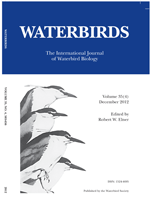Given historical patterns of decline, the American Black Duck (Anas rubripes) has long been a species of concern. To support the identification of core Maritime habitat, the distribution of breeding ducks was mapped at the landscape scale through the combination of GIS-based land cover information and five years of intensive aerial surveys (2006–2010). A predictive, mixed effects model was used to generate the maps, based on the weighted average of coefficients for the top 95% of all-possible models (as measured by AIC weights). The results of the averaged mixed model indicated that annual variation (YEAR), availability of surface water (WET_AREA, LAKE_AREA and WET_DIVERSITY) and occurrence of active agricultural landscapes (AG_PROP and ROAD_DENSITY) were strongly associated with the number of breeding pairs. The presence of larger numbers of breeding ducks in agricultural landscapes represents a departure from studies conducted in more intensively utilized regions (e.g. southern Ontario and Quebec), and suggest that the benefits of breeding in Maritime agricultural areas outweigh potential costs. Using 34,659 prediction points, duck distribution was modeled in relatively high and low years (2008 and 2006, respectively), resulting in detailed maps suitable for the identification of priority areas for habitat restoration and enhancement. In order to help refine conservation management plans, future work should more closely examine the impact of different types and combinations of Maritime agricultural production to better understand the way these landscapes attract breeding ducks.
How to translate text using browser tools
1 December 2012
The Importance of Agricultural Landscapes as Key Nesting Habitats for the American Black Duck in Maritime Canada
David J. Lieske,
Bruce Pollard,
Mark Gloutney,
Randy Milton,
Kevin Connor,
Randy Dibblee,
Glen Parsons,
David Howerter
ACCESS THE FULL ARTICLE

Waterbirds
Vol. 35 • No. 4
December 2012
Vol. 35 • No. 4
December 2012
American Black Duck
GIS
Maritimes
mixed modeling
MODEL AVERAGING
species distribution




